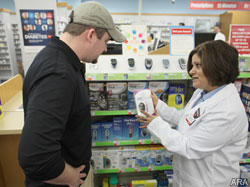
(ARA) – Medications are part of a daily routine for people with diabetes. In fact, according to the Centers for Disease Control and Prevention (CDC), 87 percent of adults diagnosed with diabetes take either insulin, oral medications or both. For these individuals, traveling requires a bit of extra planning.
CVS Pharmacist Martha Zavala reminds people that the first step to making sure you are prepared for a safe trip is to talk to your doctor or pharmacist about what to pack. The American Diabetes Association recommends that you bring twice as much medication and testing supplies as you need when traveling. Keep a stocked carry-on bag with you so necessities are always nearby.
If you are traveling by airplane, alert the security screener that you are carrying diabetes products. Some items to pack in your carry-on include enough insulin, syringes and blood testing supplies for the duration of your trip, plus additional medications and medical supplies. You should bring snacks such as cheese, peanut butter, fruit and hard candy or glucose tablets to treat low blood glucose. If you are used to having juice on hand, purchase it after going through airport security to avoid restrictions related to traveling with liquids. Don’t forget to pack your diabetes identity card in case of an emergency.
Proper medication storage is important to keep in mind. Body heat can upset the makeup of a drug, so don’t store pills in a pocket or otherwise near your body. The safest place to keep your medications is in carry-on luggage, so they will be easily accessible. Make sure to use the original pharmacy containers to avoid any confusion at security. It is important to pack insulin carefully to prevent it from breaking or overheating. Insulin does not need to be refrigerated, but if stored in very hot or very cold temperatures, it may lose strength. Travel packs can help keep your insulin at the right temperature.
Once you arrive at your destination, there are simple ways you can make sure your health is not negatively impacted by changes in your normal routine. Vacations may mean more time in the sun or increased physical activity, so be sure to have a bottle of water to stay hydrated. Monitoring your blood glucose levels is as important while traveling as when you are at home. You may be eating unfamiliar foods that have unknown effects on your blood glucose levels. If you are more active than usual, your blood glucose could go too low. Check your numbers frequently, including before eating and two to three hours after meals. If you are traveling through time zones, it may be necessary to adjust your dosing schedule so that you take your medication on time.
The supplies needed to manage diabetes at home and on the road can be expensive. One way to save is the ExtraCare Advantage for Diabetes program from CVS/pharmacy. More information on the program and diabetes care can be found at the CVS/pharmacy Diabetes Care Center .
Courtesy of ARAcontent





